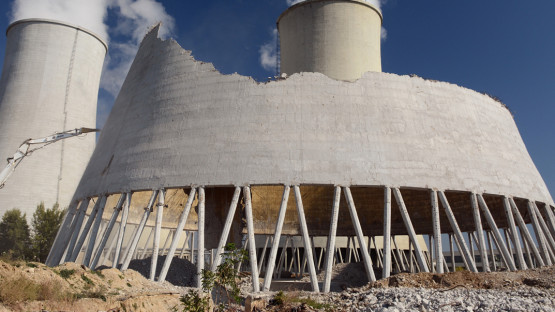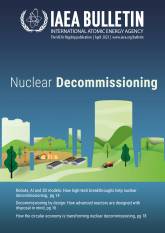
If you would like to learn more about the IAEA’s work, sign up for our weekly updates containing our most important news, multimedia and more.
Nuclear Decommissioning: Addressing the Past and Ensuring the Future
Patrick O’Sullivan

This week, the IAEA is hosting the International Conference on Nuclear Decommissioning in Vienna. The conference brings together policy makers, regulators, technical support organizations, waste management organizations, industry representatives, research and academic institutions, among others interested in decommissioning. The event provides a platform to discuss achievements, challenges and lessons learned in the decommissioning of nuclear facilities and to share information on strategies that enhance safe, secure and cost-effective implementation of decommissioning programmes. To follow the conference discussions, watch the live stream or register as an observer.
The number of nuclear facilities that require decommissioning is expected to increase significantly over the next 10 to 20 years. There is no simple relationship between the age of a facility and the timing of permanent shutdown, as multiple factors, including political and economic forces, can influence this decision (see infographic). The timing may also depend on maintenance, refurbishment costs and electricity market conditions, among other things (see Decommissioning a nuclear power plant). However, government policies are increasingly promoting strategies for immediate dismantling in line with sustainability principles, so that the burdens associated with decommissioning, such as the management of waste, are not passed on to future generations. The potential of sites to be reused for the construction of new nuclear facilities or other purposes is also an important consideration.
Timespan and budget
The decommissioning of a large nuclear facility is a complex undertaking which usually requires a significant timespan and budget. For example, the cost of decommissioning a nuclear power reactor, including the associated waste management costs, typically ranges from $500 million to $2 billion, with gas-cooled graphite moderated reactors being significantly more expensive to decommission than pressurized or boiling water reactors, owing to their much greater size and complexity. The decommissioning process typically takes around 15 to 20 years, although this can vary. The cost of decommissioning a large fuel cycle facility, such as a facility used to reprocess spent fuel, is generally around $4 billion, while the decommissioning of such facilities may take more than 30 years to complete. A research reactor with a thermal power output of 10 megawatts may cost over $20 million to decommission and take 5 to 10 years to implement, although the cost depends on the reactor’s size, purpose and operational history. However, some successful examples suggest that there is potential for a more time efficient and less expensive decommissioning process.
Biggest challenges for the decommissioning industry
The anticipated increase in the number of nuclear facilities to be permanently shut down between now and 2050 means that significant resources — human, as well as financial — will be needed to implement the necessary decommissioning programmes, some of which will run to the end of this century. For commercial facilities, funds have generally been set aside during operation to cover the costs of decommissioning. However, the decommissioning of a significant number of facilities is funded either directly or indirectly from State resources. In these cases, the availability or not of sufficient funding may delay such implementation. A large, highly skilled workforce will also be needed to implement future decommissioning programmes. Encouraging young people to pursue careers in decommissioning and radioactive waste management is one of the most significant challenges currently facing the industry.
Recycling and reusing waste material
Decommissioning results in the generation of large quantities of materials and waste, most of which have not been radioactively contaminated. Efforts are being made to ensure that a large proportion of this non-contaminated waste, including metals, concrete debris and soil, is recycled or reused, in line with circular economy principles (See here). In some cases, rubble from demolition can be used to fill the spaces that are created by the removal of structures below ground level. The greater use of metal recycling, including for reuse within the nuclear industry, is also being considered.
A large proportion of the material that has been radioactively contaminated — which typically represents about five per cent of the total material generated by decommissioning — contains very low levels of radioactivity and is suitable for disposal in near surface repositories. A small proportion of the radioactively contaminated material (less than five per cent of the total material generated) is not suitable for release from regulatory control or for near surface disposal, owing to high levels of activity and the presence of highly active or long-lived radionuclides; this material will ultimately be safely disposed of in underground disposal facilities (see infographic).
Meeting future needs
Given the extent of future decommissioning needs and the potential for new and emerging technologies to improve the efficiency of decommissioning, it is likely that there will be significant changes in project implementation in the near future, once such technologies are widely adopted and their cost-effectiveness has been proven. Developments include the application of digital techniques to support planning and to optimize project implementation; the greater use of remotely operated tools, including drones and robotics, for the segmentation of plant components, material handling, measurements and decontamination; the increased automation of waste management activities; and the use of artificial intelligence.
The role of the supply chain is crucial in ensuring that future projects are implemented as effectively and efficiently as possible. There is already evidence of supply chain organizations developing expertise to provide a wider range of decommissioning services in fields such as research and development on new technologies, engineering, dismantling and radioactive waste management. A recent development specific to nuclear power plant decommissioning has been the emergence of decommissioning consortia that bring together specialized companies in order to implement entire decommissioning projects within a fixed budget, by following standardized approaches and assuming all associated project risks (see here).
__________________________________________________
What is nuclear decommissioning?
In the nuclear energy industry, ‘decommissioning’ is an umbrella term given to all activities that enable nuclear facilities to be permanently shut down, decontaminated, dismantled and released from regulatory control. Decommissioning is not complete until radioactive and other hazardous materials have been removed from the site, and the buildings and land which were formerly used as nuclear facilities have been prepared for new uses. The final step (of the decommissioning process) involves extensive surveys to confirm the absence of any significant radioactivity on the site, enabling its release from regulatory control.
Infographic: Global decommissioning in numbers






